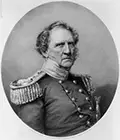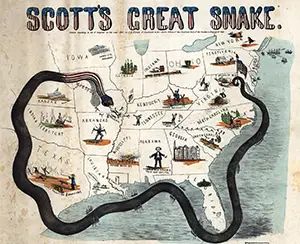The Anaconda Plan: Civil War Blueprint for Success
The Anaconda Plan was a wartime strategy devised by U.S. Army commander Winfield Scott to bring the Southern states back into the Union. 
Scott, long the Army's chief officer, proposed the plan in early 1861. The multifaceted plan involved both military and economic elements and aimed to squeeze the operating life out of the Confederacy, moreso by denial of vital resources than by wholesale attack. Newspapers of the day, picking up on the metaphorical nature of the strategy, dubbed it the Anaconda Plan. One of the primary elements of the plan was to institute a naval blockade of both the Atlantic and Gulf coasts, preventing the South from importing goods and weapons and, perhaps more importantly, preventing the export of goods like cotton, the South's major crop export. Scott anticipated a gradual realization by the people in the South that the rebellion was pointless, especially once shortages of food and other goods began, and that the only resort was to return to the Union. 
The other primary goal of the plan was to seize control of the Mississippi River, both the waterway itself and the areas around it. The goal of this part of the plan was to split the Confederacy into two spheres, with Arkansas, Louisiana, Missouri, and Texas cut off from the more numerous eastern sphere. As well, if the Union had control of the Mississippi River, then attacks on Tennessee would be easier to achieve and Kentucky might be more convinced to keep its neutrality. The plan was ambitious and far-reaching and required a large amount of money and manpower to work properly. President Abraham Lincoln wanted a quick strike against the enemy, not a long or drawn-out buildup of troops and so didn't endorse the part of the Anaconda Plan that called for a large-scale force seizing control of the Mississippi River. Lincoln did like the idea of a naval blockade and signed off on that part of the plan. The blockade was somewhat successful at interrupting Southern imports and exports. However, the sheer size of the two coasts proved problematic for Union ships hoping to seize any and all Confederate blockade-runners. Perhaps more importantly, the presence of the blockade was one of the elements that ultimately convinced the United Kingdom from either trading with the South or recognizing it as a sovereign entity. Later events, namely the seizure of Vicksburg by Ulysses S. Grant, validated Scott's foresight about the importance of the Mississippi River. |
|
Social Studies for Kids
copyright 2002–2024
David White




